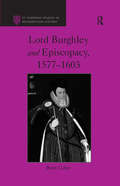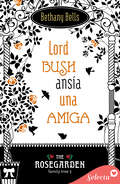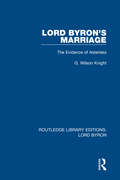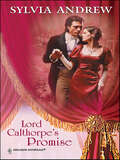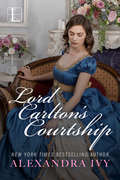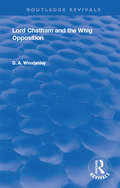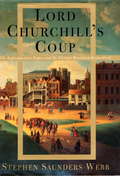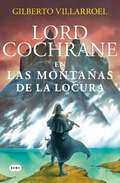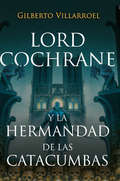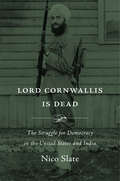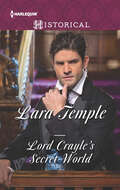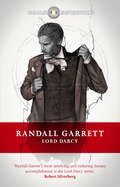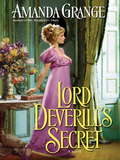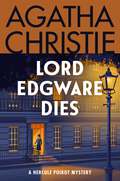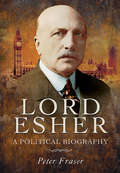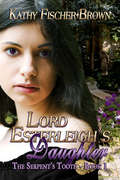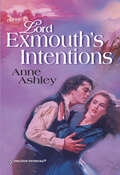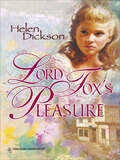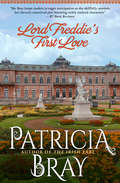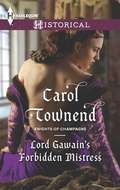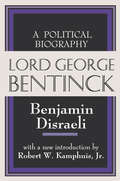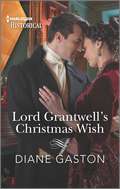- Table View
- List View
Lord Burghley and Episcopacy, 1577-1603 (St Andrews Studies in Reformation History)
by Brett UsherLord Burghley and Episcopacy, 1577-1603 examines the selection and promotion of bishops within the shifting sands of ecclesiastical politics at the Elizabethan court, drawing on the copious correspondence of leading politicians and clerical candidates as well as the Exchequer records of the financial arrangements accompanying each appointment. Beginning in 1577, the book picks up the narrative where Brett Usher's previous book (William Cecil and Episcopacy, 1559-1577) left off, following the fall of Archbishop Grindal, which brought the Elizabethan church to the brink of disaster. The book begins with an outline of the period under review, challenging the traditional view of corruption and decline. Instead Usher provides a more complex picture, emphasizing the importance of court rivalries over patronage and place, and a broadly more benign attitude from the Exchequer, which distinguishes the period from the first half of the reign. Within this milieu the book situates the dominance of the Cecils - father and son - in ecclesiastical affairs as the key continuity between the two halves of Elizabeth's reign. Providing a fresh analysis of the Burghley's long and influential role within Elizabethan government, Usher both illuminates court politics and the workings of the Exchequer, as well as the practical operation of Elizabeth's supremacy. Specifically he demonstrates how Elizabeth learnt a valuable lesson from the debacle over the fall of Grindal, and from the late 1570s, rather than taking the lead, customarily she looked to her councillors and courtiers to come to some accommodation with each other before she would authorize appointments and promotions. Note: Brett Usher died in 2013 before the publication of this book. Final editing of the typescript was undertaken by Professor Kenneth Fincham of the University of Kent, who also guided the book through the publication process.
Lord Bush ansía una amiga (The Rosegarden Family Tree #Volumen 3)
by Bethany BellsCuando los sentimientos entran en conflicto, el amor siempre sabe encontrar el camino. Lord Bush Rosegarden nunca ha sentido que encajase en su familia. Aunque se sabe atractivo, carece de la belleza oscura de sus hermanos y de su sentido perverso de afrontar la vida. A diferencia de ellos, es serio, formal, no concibe la idea de perder el tiempo con diversiones vacías y solo cuenta con un amigo de verdad, Henry Claredon. Bush y Claredon siempre han querido ser médicos, una profesión que los hace sentir bien, porque les resulta grato ayudar a otros y procurarles un poco de alivio y alegría en los malos momentos. Han estudiado juntos y ahora trabajan con un médico, adquiriendo práctica. Pero, todos los proyectos de vida de Bush, tan claros, ordenados y perfectos se rompen en mil pedazos cuando sus ojos se encuentran con los de la señorita Caroline Mildmay, la prometida de su amigo.Caroline Mildmay llega a Londres acompañada de su tía para casarse con el hombre al que ha estado siempre prometida. Es feliz, quiere a Henry, siempre lo ha querido, pero todo se complica cuando conoce a lord Bush y se da cuenta de que ese amor que sentía no era más que una sombra de lo que solo ahora empieza a experimentar.
Lord Byron and Scandalous Celebrity
by Clara TuiteThe Regency period in general, and the aristocrat-poet Lord Byron in particular, were notorious for scandal, but the historical circumstances of this phenomenon have yet to be properly analysed. Lord Byron and Scandalous Celebrity explores Byron's celebrity persona in the literary, social, political and historical contexts of Regency Britain and post-Napoleonic Europe that produced it. Clara Tuite argues that the Byronic enigma that so compelled contemporary audiences - and provoked such controversy with its spectacular Romantic Satanism - can be understood by means of 'scandalous celebrity', a new form of ambivalent fame that mediates between notoriety and traditional forms of heroic renown. Examining Byron alongside contemporary figures including Caroline Lamb, Stendhal, Napoleon Bonaparte and Lord Castlereagh, Tuite illuminates the central role played by Byron in the literary, political and sexual scandals that mark the Regency as a vital period of social transition and emergent celebrity culture.
Lord Byron's Marriage: The Evidence of Asterisks (Routledge Library Editions: Lord Byron #6)
by G. Wilson KnightFirst published in 1957. This title explores the brief marriage of Lord Byron and his wife Annabella Millbanke, and the scandal that surrounded their relationship. The exact reason for their separation and eventual divorce was never confirmed, but G. Wilson Knight uses Byron’s poetry, letters and other published works to develop and expand the theories of other literary critics. This title will be of interest to students of literature.
Lord Calthorpe's Promise
by Sylvia AndrewAn Honorable PromiseLord Adam Calthorpe had been rash in his promise to look out for a fellow soldier’s sister before the soldier was killed at the battle of Waterloo. For Miss Katherine Payne was a golden-eyed shrew who took genuine delight in flouting Adam’s authority at every turn.Surely bringing her to stay with his mother for the Season would absolve him of his responsibilities-though he sincerely doubted such a headstrong young woman would ever find herself a husband in the marriage mart. But when an unscrupulous man starts pursuing Katherine, Adam comes to realize that fulfilling his promise might actually involve marrying her himself....
Lord Carlton's Courtship
by Alexandra IvyDear Reader, Long before I wrote my sexy paranormal romances, I wrote traditional Regency romances as Debbie Raleigh. I’m thrilled that one of my favorites is now available again, brimming with adventure and romance . . . Miss Roma Allendyle detested behaving like a proper lady, and all the accompanying nonsense. After all, she could outride and outshoot any gentleman. If finding her vanished brother, an agent of the Crown, required her to disguise herself as a grubby lad, so be it. She expected to face challenges, but not to be waylaid by a mysterious ambush, wounded by a bullet—and rescued by the darkly handsome Lord Giles Carlton, the Season’s prime catch. Worse, in return for his aid, Giles has taken an imperious interest in her affairs and insists on helping with her search. But that is not the last surprise. For in Giles, Roma just may find a will to match her own, a passion to rival her fierce pride—and an outlandish ploy that could lead to true love . . . I’ve fallen for this thrilling tale all over again, and believe you will too.Alexandra Ivy
Lord Chatham and the Whig Opposition (Routledge Revivals)
by D. A. WinstanleyOriginally published in 1966, this book examines the struggle between the whig factions and the crown during a period of George III's reign. During the short period, the destinites of the nation were determined and the work of the Revolution nullified; never before had the opponents of personal government been given such a favourable opportunity to thwart the execution of the royal schemes, and yet they failed hopeleslly. Lord Chatham and the Whig Opposition includes chapters covering the formation of Chatham's administration, the rise and fall of the opposition, and its downfall.
Lord Churchill's Coup: The Anglo-American Empire and the Glorious Revolution Reconsidered
by Stephen S. WebbIn LORD CHURCHILL’S COUP, Stephen Saunders Webb further advances his revisionist interpretation of the British Empire in the seventeenth century. Having earlier demonstrates that the Anglo=American empire was classic in its form, administered by an army, committed to territorial expansion, and motivated by crusading religion, Webb now argues that both England and its American social experiments were the underdeveloped elements of an empire emerging on both sides of the Atlantic and that the pivotal moment of that empire, the so-called “Glorious Revolution,” was in fact a military coup driven by religious fears. <P><P> In a vigorous narrative, Webb populates this formative period of the Anglo-American past with colorful and commanding characters. At the center is John Churchill. We see him rise from page boy to earl of Marlborough, winning battlefield glory, influence, and promotion; and his corresponding rise from ensign of the English army taking control of the destiny of the later Stuart monarchs of Britain and America. <P> Webb shows us Churchill increasingly alarmed by the Catholicizing course of his patron, James II, and becoming instrumental in the organization of a successful coup to protect Anglicanism and the constitution. We see the resulting alliance with William of Orange, the Protestant champion of Europe, quickly turn sour as William makes himself king; and we see Churchill, now transformed into imperial politician, once again in power—able to secure the succession of Queen Anne and negotiate the terms of resumption of war against France. <P> Throughout, Webb makes it clear that at the heart of Churchill’s ascent and actions is his vision of America as a decisive factor in the world war between England and France for impersonal supremacy. As the book ends, Churchill’s American agenda thus becomes central to the war aims of the Grand Alliance.
Lord Cochrane en las montañas
by GILBERTO VILLARROELEl audaz marino encuentra un mundo subterráneo bajo las tierras del sur de Chile. Las coordenadas del corsario Selkirk llevan a Lord Cochrane y sus acompañantes hasta una cadena montañosa, los Cuernos del Diablo, ubicada al norte del Estrecho de Magallanes. Esta resulta ser la entrada a un monumental túnel que conduce, bajo el Mar de Drake, hasta Deception Island, en territorio antártico. El audaz marino ensambla su prototipo de locomotora, The Rocket, y a bordo de ella inicia el descenso hacia aquel mundo subterráneo, que fue el primer hogar en la Tierra del dios Cthulhu. Pero las Montañas de la Locura no están desiertas. Bajo ellas vive todavía una raza ancestral de científicos: los Antiguos. Y un puñado de piratas, encabezados por el capitán Corrochano, un viejo enemigo de Cochrane, amenaza la vida de The Sea Wolf y los suyos. ¡Lord Cochrane, Maria Graham y el capitán Eonet enfrentarán peligros mortales en este arriesgado viaje a través de terra incognita!
Lord Cochrane y la hermandad de las catacumbas
by Gilberto Villarroel¡El marino más audaz de todos los tiempos vivirá una nueva aventura! Francia, 1826. Lord Cochrane recibe un mensaje de auxilio del profesor Jean-François Champollion, jefe de la Sección de Antigüedades Egipcias del Museo del Louvre. Él ha descubierto un testimonio escrito por Julio César en el 52 a.C., que podría ser la clave sobre la primera aparición del dios extraterrestre, Cthulhu. Pero alguien más está detrás de ese manuscrito; una misteriosa hermandad secreta, encabezada por una alta figura de la Iglesia. Y está dispuesta a todo por conseguirlo. Cochrane deberá luchar entonces contra este nuevo enemigo: los poderosos seguidores de un culto siniestro. ¿Qué peligros encontrará en los cementerios,catedrales y catacumbas de París? Reseña: "La novela tiene una profunda investigación, privilegiando los detalles históricos, la ambientación y una muy cuidada atmósfera." Jorge Baradit
Lord Cornwallis Is Dead: The Struggle for Democracy in the United States and India
by Nico SlateDo democracies bring about greater equality among their citizens? India embraced universal suffrage in 1947 and yet its citizens are far from realizing equality. The U.S. struggles with intolerance and inequality well into the twenty-first century. Nico Slate offers a new look at the struggle for freedom that linked two former British colonies.
Lord Crayle's Secret World: The Secrets Of Wiscombe Chase An Earl In Want Of A Wife Lord Crayle's Secret World (Mills And Boon Historical Ser.)
by Lara TempleA desperate highwaywoman’s attempt to rob a dashing spymaster leads to an enticing arrangement in this thrilling Regency romance.Holding a lord at gunpoint, Miss Sari Trevor wonders how it came to this. One look into the icy gray eyes of Michael D’Alency Alistair, Earl of Crayle, and she knows she’s out of her depth. But then, this enigmatic lord makes Sari a mysterious offer of employment . . .Although she challenges his rigid self-control, Sari is perfect for the secret agency of spies Michael manages. But helping tutor this daring beauty proves to be a sensual assault Michael isn’t prepared for . . . and a temptation neither can resist!
Lord Darcy (FANTASY MASTERWORKS)
by Randall GarrettWelcome to a world where the Plantagenet kings survived, the laws of magic were discovered and the physical sciences never pursued. In the resulting Anglo-French Empire, a detective like Lord Darcy needs more than a keen mind and an observant eye. Luckily, Darcy can call on the aid of Master Sean O'Lochlainn, forensic sorcerer.This omnibus contains all of the Lord Darcy stories as well as the only Lord Darcy novel, TOO MANY MAGICIANS, and has a new introduction by Michael Dirda.
Lord Dashwood Missed Out: A Spindle Cove Novella
by Tessa DareA snowstorm hath no fury like a spinster scornedMiss Elinora Browning grew up yearning for the handsome, intelligent lord-next-door...but he left England without a word of farewell. <P><P>One night, inspired by a bit too much sherry, Nora poured out her heartbreak on paper. Lord Dashwood Missed Out was a love letter to every young lady who'd been overlooked by gentlemen--and an instant bestseller. Now she's on her way to speak in Spindle Cove when snowy weather delays her coach. She's forced to wait out the storm with the worst possible companion: Lord Dashwood himself.And he finally seems to have noticed her.George Travers, Lord Dashwood, has traveled the globe as a cartographer. He returned to England with the goal of marrying and creating an heir--only to find his reputation shredded by an audacious, vexingly attractive bluestocking and her poison pen. Lord Dashwood Missed Out, his arse. Since Nora Browning seems to believe he overlooked the passion of a lifetime, Dash challenges her to prove it.She has one night.
Lord Deverill's Secret
by Amanda GrangeA delightful tale of romance and intrigue from the acclaimed author of Mr. Knightley's Diary. Arriving in Brighton, Cassandra Paxton had one important task-to uncover the meaning of a letter she'd found amidst her late brother's belongings. She knew of only one man who could help her: Lord Deverill, who just happened to be the most eligible bachelor in all of Brighton. But what she didn't realize-until it was too late-was that the handsome earl had a secret of his own. One that might prevent him from telling her the truth-and one that made a marriage between them impossible. Which was most unfortunate, considering the way his gentle touch made Cassandra's pulse quicken.
Lord Dufferin, Ireland and the British Empire, c. 1820–1900: Rule by the Best? (Routledge Studies in Modern British History)
by Annie TindleyThis book explores the life and career of Frederick Temple Hamilton-Temple-Blackwood, 1st Marquess of Dufferin and Ava (1826–1902). Dufferin was a landowner in Ulster, an urbane diplomat, literary sensation, courtier, politician, colonial governor, collector, son, husband and father. The book draws on episodes from Dufferin’s career to link the landowning and aristocratic culture he was born into with his experience of governing across the British Empire, in Canada, Egypt, Syria and India. This book argues that there was a defined conception of aristocratic governance and purpose that infused the political and imperial world, and was based on two elements: the inheritance and management of a landed estate, and a well-defined sense of ‘rule by the best’. It identifies a particular kind of atmosphere of empire and aristocracy, one that was riven with tensions and angst, as those who saw themselves as the hereditary leaders of Britain and Ireland were challenged by a rising democracy and, in Ireland, by a powerful new definition of what Irishness was. It offers a new perspective on both empire and aristocracy in the nineteenth century, and will appeal to a broad scholarly audience and the wider public.
Lord Edgware Dies: A Hercule Poirot Mystery (Hercule Poirot Mysteries #9)
by Agatha ChristieWhen Lord Edgware Dies a most unnatural death, detective Hercule Poirot must solve a most confounding conundrum: if the obvious killer, the slain peer’s spiteful wife, didn’t do it, who did? A classic from the queen of mystery, Agatha Christie.When Lord Edgware is found murdered the police are baffled. His estranged actress wife was seen visiting him just before his death and Hercule Poirot himself heard her brag of her plan to “get rid” of him.But how could she have stabbed Lord Edgware in his library at exactly the same time she was seen dining with friends? It’s a case that almost proves to be too much for the great Poirot.
Lord Esher: A Political Biography
by Peter FraserAlthough wielding huge influence in late Victorian and Edwardian political life, Reginald Baliol Brett (1852 1930), the second Lord Esher was, an enigma to his contemporaries and still remains a puzzle to historians.At the heart of British and Imperial political affairs for several decades, Esher sat in both Houses of Parliament, was a high ranking civil servant, friend and confidential advisor to three Sovereigns and four Prime Ministers (of differing political hues) and yet refused high office offered by both Liberals and Conservatives. Yet his behind-the-scenes influence through his range of friends in high places gave him unmatched, some thought undemocratic, power. Despite his lack of military service he was instrumental through his work on the Committee for Imperial Defence (CID) and its Secretarial for the wholesale reorganisation of the Armed Forces. It could be said that Esher, with his grasp of power without responsibility, was a unique phenomenon in British history.The Author, while compiling this fascinating study, drew on Cabinet and CID files, the Royal Archives and the papers of the Esher, Balfour, Asquith and Lloyd George estates. The result is a brilliant readable yet scholarly addition to British political bibliography.
Lord Esterleigh's Daughter (The Serpent's Tooth #1)
by Kathy Fischer-BrownAs a child, Anne Fairfield dreams of the father she never knew, the hero who died fighting the French and their Indian allies in a land across the sea. Her mother’s stories, and fantasies of her own devising, sustain and nurture her through a poor and lonely existence. Until one winter night, a strange man comes to call, and the life she has known comes crashing down like shattered glass. Forced to confront sordid truths, secrets and lies, the headstrong young woman begins to learn that, like generations of Darvey women ruled by their hearts, she is destined to follow in their footsteps. Set against the backdrop of 18th century England, Lord Esterleigh’s Daughter is the first book in “The Serpent’s Tooth” trilogy, which follows Anne from the rural countryside, to London society and into the center of the American Revolution.
Lord Exmouth's Intentions
by Anne AshleyA young woman disappears. A husband is suspected of murder. Stirring times for all the neighborhood.Demure vicar's daughter Robina Percival has relished her Season in Town-a definite change for the better after her somewhat straitened situation at home. But what is she to make of Daniel, Lord Exmouth? A widower with two daughters to raise, he appears to be in the market for a wife. Discovering that she has more spirit than she realized, Robina holds back from encouraging her potential suitor. How can she be sure he hasn't buried his heart with his beautiful wife?Regency DramaIntrigue, mischief...and marriageThe Steepwood Scandal
Lord Fox's Pleasure
by Helen DicksonMARRIAGE IN MINDWith the restoration of King Charles II to the throne, his exiled supporters were jubilantly returning home, wealthy landowner Lucas Fox among them. Once a notorious pleasure seeker, Lord Fox now found himself ready to settle down to a quiet life on his estate. All that was missing was a wife....Proud and impulsive Prudence Fairworthy captured his interest-and made his blood run hot. Pru was suspicious of his true motives and the mystery surrounding his past, and Lucas knew she would not be won over easily. But there was untold pleasure to be found in the art of persuasion....
Lord Freddie's First Love
by Patricia BrayA viscount is enraptured—but gossips might get in the way of romance—in this Regency tale by an author acclaimed for &“absorbing storytelling&” (Booklist). Despite having proposed to more than a dozen women, Viscount Frederick remains one of London&’s most eligible bachelors. The debutantes simply don&’t find him dashing enough for their tastes. His pride stinging from his latest rejection, Freddie leaves London for his country estate. After six years abroad, Anne Webster has returned to New Biddeford with a child at her side—a child whose unruly red hair and mischievous green eyes leave society gossips quite sure of the identity of his mother. Though five-year-old Ian is really Anne&’s nephew, nothing could quiet the scandal or erase the stigma once the ton started talking. Anne&’s childhood companion, Viscount Frederick, was the only person to offer friendship—and then, a rapturous love. But how could Anne allow Freddie to destroy his life by marrying a woman with a tarnished reputation such as hers?
Lord Gawain's Forbidden Mistress
by Carol TownendForbidden fruit always tastes the sweetest... Elise keeps her cards close to her chest. Few people know that she's also Blanchefleur le Fay, the celebrated singer. But she has an even greater secret... Her baby daughter is the result of a brief but intense affair with Gawain, Count of Meaux. Duty-bound to marry, Gawain is back in Troyes to meet his bride. So why can't he stop thinking about the sweet, silver-voiced girl he met the last time he was there? And when he finds his mistress again, Gawain must choose between duty and forbidden desire... Knights of Champagne Three Swordsmen for Three Ladies
Lord George Bentinck: A Political History
by Benjamin DisraeliLord George Bentinck is an account of Disraeli's relation with his parliamentary colleague and friend. It is not simply an account of the battle over the Corn Laws with Sir Robert Peel, but a most remarkable book, extremely readable, and full of often quoted and apt comments and descriptions. As a vivid story of one of the great parliamentary dramas in British history it is unsurpassed. The portraits of both Bentinck and Peel are both sympathetic and just. The book provides insight into mid-nineteenth century parliamentary life that remains unsurpassed.It is hard to overstate the bitterness and fury which Peel's decision to repeal the Corn Laws had provoked in British politics. One biographer of Disraeli, Robert Blake, spoke of "Home Rule in 1886 and Munich in 1938 as the nearest parallels". Friendships were sundered, families divided, and the feuds of politics carried into private life to a degree quite unusual in British history. Those who are interested in the details of parliamentary warfare which raged until Peel's fall from power should consult Lord George Bentinck. But the worth of this book goes beyond constitutional history or even the Irish food famine. Disraeli helps explain the intellectual and ideological grounds of the Young England Movement: a conservative force that aimed at a union of discontented industrial workers with aristocratic landowners and against factious Whigs, selfish factory owners and dissenting shopkeepers. In forging such a policy of principle, the Conservatives, as Disraeli's book well demonstrates, became a minority party but one which carried the full weight of moral politics.
Lord Grantwell's Christmas Wish (Captains of Waterloo #2)
by Diane GastonHe wished to never see her againNow he wishes she&’ll stay…Lord Grantwell hasn&’t seen Lillian Pearson since she betrayed him years ago. So when she arrives on his doorstep looking for sanctuary, he&’s not inclined to offer it! But when the two orphaned children in his care ask if she can stay for Christmas, how can he refuse? Grant and Lillian discover an intense attraction still simmers between them, and Grant starts to wonder if he has done her a grave injustice…From Harlequin Historical: Your romantic escape to the past.Captains of WaterlooBook 1: Her Gallant Captain at WaterlooBook 2: Lord Grantwell's Christmas Wish
